
You can still see them out there every day. The clusters of people on the sidewalk, gathered in front of a large house on the eastern side of the French Quarter, listening to their black-caped tour guide. He waves his hands, gestures dramatically, lowers his voice in hushed tones. The people are rapt, hanging on every word. They stay in front of this house longer than any other: at the end of his tale, he collects his tips, moves on to the next willing victims.
Thanks to its colorful, often sordid history, New Orleans remains home to a vibrant tourism industry whose visitors search daily for the darkest stories in its closets. Easily one of the most famous stories concerns the “Mad Madame” Delphine MacCarthy LaLaurie, the beautiful French aristocrat from the 19th century who was discovered to have imprisoned, tortured, and murdered dozens of slaves. Numerous legends surround her life, her misdeeds, and even her death, many of which are repeated verbatim today.

But how much of it is true? Did she really chain her slaves to an upstairs attic wall? Did she really, along with her deranged physician husband, break and re-set the bones of a slave woman to make her scuttle across the floor like a crab? Did she really cover enslaved men in honey just to watch ants and roaches devour them alive? Did she really—one can only hope—serve as a godmother to a ‘devil baby’ given to her by none other than voodoo queen Marie Laveau?
Passionate about local history, authors Victoria Cosner Love and Lorelei Shannon set out to investigate the myths, and separate fact from fiction over the span of nearly 200 years. In their book Mad Madame LaLaurie: New Orleans’ Most Famous Murderess Exposed, they take a hard look at each part of the story, examining each new detail afresh. Beginning at the beginning—with what we know about LaLaurie’s birth and upbringing, and concluding not merely with her flight from the Crescent City after her misdeeds were discovered, but with how she lived out her days thereafter—Love and Shannon cover every inch of this legendary lady’s life.
Along the way, one of their chief aims is to debunk the lies, the embellishments, and the sensationalizing that surrounds her. Take, for instance, a plaque that was ‘discovered’ in one of New Orleans’ historic cemeteries, St. Louis No. 1. This plaque, found in 1964 near a family tomb associated with the madame’s forbears, purported to record the date (1842) and place (Paris) of LaLaurie’s death. Unfortunately, Love and Shannon point out, this plaque is none other than a clever hoax, as LaLaurie appears in legal documents in 1850, arguing before none other than the Louisiana Supreme Court.

Such ‘discoveries’ are, of course, tantalizing, and the cleverer the hoax, the better, right? Except when the desire for a good story outpaces the commitment to a good fact—and as Love and Shannon record, as many questions still persist, there are plenty of actual facts to go on in the LaLaurie case. Helpfully, they provide a long list of facts and myths in their book, as well as a carefully-researched chronology and genealogy, to help readers interested in the case come better equipped to explore this darkened corner of the Crescent City’s past.
If you or someone you know is planning to visit the LaLaurie mansion anytime soon, it’s required reading (plus the images of the devil baby are, as New Orleanians say, lagniappe). Just don’t show it to your tour guide—he might chain you to that attic wall himself!




